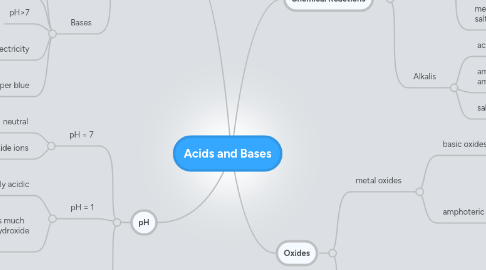
1. Properties
1.1. Acids
1.1.1. sour
1.1.2. pH<7
1.1.3. conduct electricity
1.1.3.1. strong acids conduct better because complete dissociation of acid molecules lead to higher concentration of hydrogen ions
1.1.4. turns moist blue litmus paper red
1.2. Bases
1.2.1. bitter taste
1.2.2. slippery feel
1.2.3. pH>7
1.2.4. soluble bases conduct electricity
1.2.4.1. strong alkalis conduct better because complete dissociation of alkali molecules lead to higher concentration of hydroxide ions
1.2.5. turns moist red litmus paper blue
2. pH
2.1. pH = 7
2.1.1. neutral
2.1.2. conc. hydrogen ions = conc. hydroxide ions
2.2. pH = 1
2.2.1. very strongly acidic
2.2.1.1. strong acids dissociate completely in water to give high conc. hydrogen ions
2.2.2. conc. hydrogen ions much higher than conc. hydroxide ions
2.3. pH = 14
2.3.1. very strongly alkaline
2.3.1.1. strong alkalis dissociate completely in water to give high conc. hydroxide ions
2.3.2. conc. hydrogen ions much lower than conc. hydroxide ions
3. Chemical Reactions
3.1. Acids
3.1.1. bases (products: salt and water)
3.1.2. metals (products: salt and hydrogen)
3.1.2.1. Exception 1: dil. nitric acid reacts with reactive metals produces salt, nitrogen dioxide and water instead of salt and hydrogen
3.1.2.2. Exception 2: un-reactive metals such as copper, silver and gold do not react with acids
3.1.3. metal carbonates (products: salt, carbon dioxide and water)
3.2. Alkalis
3.2.1. acids (products: salt and water)
3.2.2. ammonium salts (product: salt, ammonia and water
3.2.3. salt (product: metal hydroxides and new salt)
3.2.3.1. For identification of cations (QA)
4. Oxides
4.1. metal oxides
4.1.1. basic oxides
4.1.1.1. oxides of all metals except ZAP
4.1.1.2. behave like bases. Have reactions typical of bases
4.1.2. amphoteric oxides
4.1.2.1. ZAP (zinc, aluminium and lead(II) oxides)
4.1.2.2. can behave as base or acid. Have reactions with acids and bases
4.2. non metal oxides
4.2.1. acidic oxides
4.2.1.1. oxides of all non metal except those that are neutral oxides
4.2.1.2. behave like acids. Have reactions typical of acids
4.2.2. neutral oxides
4.2.2.1. CO, NO, H2O
4.2.2.2. does not behave as acid or base. No reaction with acids and bases
